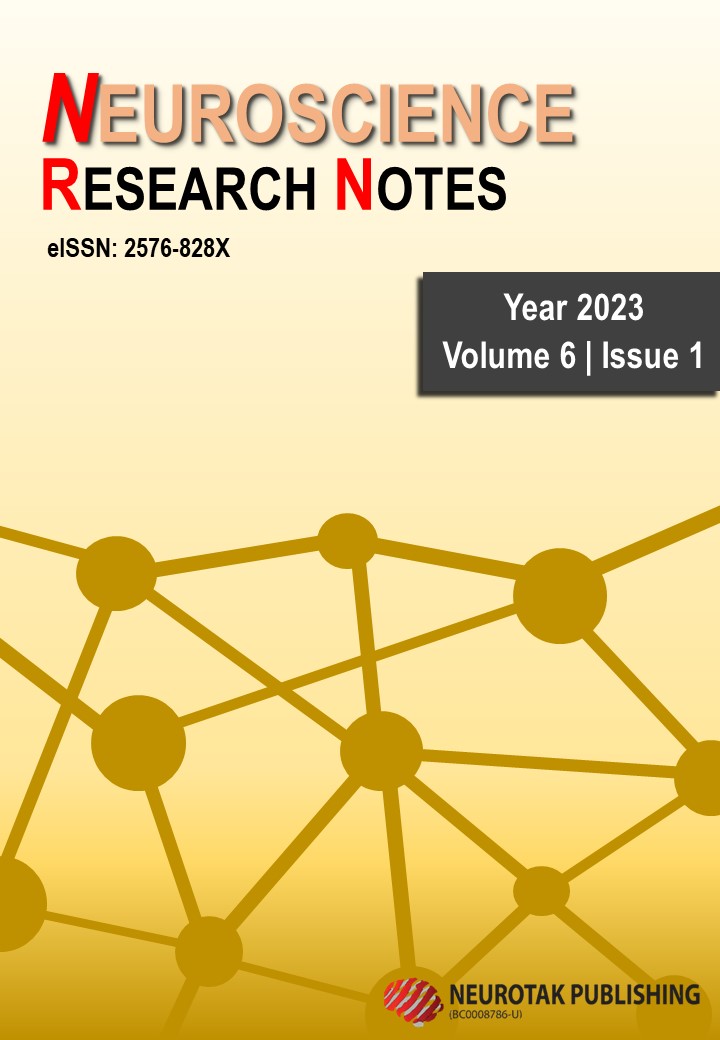Drawing on paper versus drawing on a tablet: an EEG study
DOI:
https://doi.org/10.31117/neuroscirn.v6i1.170Keywords:
EEG, ERD/ERS, drawing, paper, tablet, cognitive taskAbstract
Drawing is an activity that requires visual, emotional, and movement skills. This study compares, for the first time, children's brain activity during drawing on paper versus drawing on a tablet. First, we examined drawing activity in 26 right-handed children using the EEG combined with Event-Related Desynchronization (ERD) and Event-Related Synchronization (ERS) methods. Then, we asked participants to copy a house model where we used a Neurosoft EEG system to record the data and analyse it using the Brainstorm application. Both experimental conditions activate the brain's anterior and posterior cortices, but the activity in the anterior cortices was slightly higher during the drawing on paper than on the tablet. Conversely, compared to the paper condition, brain activity in the posterior cortices was slightly higher while drawing on the tablet.
References
Durka, P.J., Ircha, D., Neuper, C., & Pfurtschellr, G. (2001). Time-frequency microstructure of event-related electro-encephalogram desynchronisation and synchronisation. Medical & Biological Engineering & Computing, 39, 315–321 https://doi.org/10.1007/BF02345286
Ferber, S., Mraz, R., Baker, N., & Graham, S. J. (2007). Shared and differential neural substrates of copying versus drawing: a functional magnetic resonance imaging study. Neuroreport, 18(11),1089–1093. https://doi.org/10.1097/WNR.0b013e3281ac2143
Flores L. P. (2002). Occipital lobe morphological anatomy: anatomical and surgical aspects. Arquivos de Neuro-psiquiatria, 60(3-A), 566–571. https://doi.org/10.1590/s0004-282x2002000400010
Guérin, F., Ska, B., & Belleville, S. (1999). Cognitive processing of drawing abilities. Brain and Cognition, 40(3), 464–478. https://doi.org/10.1006/brcg.1999.1079-
Harrington, G. S., Farias, D., Davis, C. H., & Buonocore, M. H. (2007). Comparison of the neural basis for imagined writing and drawing. Human Brain Mapping, 28(5), 450–459. https://doi.org/10.1002/hbm.20286
Hawes, Z., Sokolowski, H. M., Ononye, C. B., & Ansari, D. (2019). Neural underpinnings of numerical and spatial cognition: An fMRI meta-analysis of brain electrode sites associated with symbolic number, arithmetic, and mental rotation. Neuroscience and Biobehavioral Reviews, 103, 316–336. https://doi.org/10.1016/j.neubiorev.2019.05.007
Ino, T., Asada, T., Ito, J., Kimura, T., & Fukuyama, H. (2003). Parieto-frontal networks for clock drawing revealed with fMRI. Neuroscience Research, 45(1), 71–77. https://doi.org/10.1016/s0168-0102(02)00194-3
Keisker, B., Hepp-Reymond, M. C., Blickenstorfer, A., Meyer, M., & Kollias, S. S. (2009). Differential force scaling of fine-graded power grip force in the sensorimotor network. Human Brain Mapping, 30(8), 2453–2465. https://doi.org/10.1002/hbm.20676.
Liao, K., Xiao, R., Gonzalez, J., & Ding, L. (2014). Decoding Individual Finger Movements from One Hand Using Human EEG Signals. PLOS ONE, 9(1): e85192. https://doi.org/10.1371/journal.pone.0085192
Longcamp, M., Zerbato-Poudou, M. T., & Velay, J. L. (2005). The influence of writing practice on letter recognition in preschool children: a comparison between handwriting and typing. Acta Psychologica, 119(1), 67–79. https://doi.org/10.1016/j.actpsy.2004.10.019
Makuuchi, M., Kaminaga, T., & Sugishita, M. (2003). Both parietal electrode sites are involved in drawing: a functional MRI study and implications for constructional apraxia. Brain research. Cognitive Brain Research, 16(3), 338–347. https://doi.org/10.1016/s0926-6410(02)00302-6
McCrea, S. (2014). A neuropsychological model of free-drawing from memory in constructional apraxia: a theoretical review. American Journal of Psychiatry Neuroscience, 2, 60–75. https://doi.org/10.11648/j.ajpn.20140205.11
Meulenbroek, R. G., Van Galen, G. P., Hulstijn, M., Hulstijn, W., & Bloemsaat, G. (2005). Muscular co-contraction covaries with task load to control the flow of motion in fine motor tasks. Biological Psychology, 68(3), 331–352. https://doi.org/10.1016/j.biopsycho.2004.06.002
Ogawa, K., & Inui, T. (2009). The role of the posterior parietal cortex in drawing by copying. Neuropsychologia, 47(4), 1013–1022. https://doi.org/10.1016/j.neuropsychologia.2008.10.022
Ose Askvik, E., van der Weel, F., & van der Meer, A. (2020). The Importance of Cursive Handwriting Over Typewriting for Learning in the Classroom: A High-Density EEG Study of 12-Year-Old Children and Young Adults. Frontiers in Psychology, 11, 1810. https://doi.org/10.3389/fpsyg.2020.01810
Panesi, S., & Morra, S. (2018). Relationships between the early development of drawing and language: the role of executive functions and working memory. The Open Psychology Journal, 11(1). DOI: 10.2174/1874350101811010015
Pfurtscheller, G. (2001). Functional brain imaging based on ERD/ERS. Vision Research, 41(10-11), 1257–1260. https://doi.org/10.1016/s0042-6989(00)00235-2
Picard, D., Martin, P., & Tsao, R. (2014). iPads at school? A quantitative comparison of elementary schoolchildren's pen-on-paper versus finger-on-screen drawing skills. Journal of Educational Computing Research, 50(2), 203-212.
Roncato, S., Sartori, G., Masterson, J., and Rumiati, R. (1987).Constructional apraxia: an information-processing analysis. Cognitive Neuropsychology, 4, 113–129. https://doi.org/10.1080/02643298708252037
Saggar, M., Quintin, E. M., Bott, N. T., Kienitz, E., Chien, Y. H., Hong, D. W., Liu, N., Royalty, A., Hawthorne, G., & Reiss, A. L. (2017). Changes in brain activation associated with spontaneous improvization and figural creativity after design-thinking-based training: a longitudinal fMRI Study. Cerebral Cortex, 27(7), 3542–3552. https://doi.org/10.1093/cercor/bhw171
Sommers, P. V. (1989). A system for drawing and drawing related neuropsychology. Cognitive Neuropsychology, 6, 117–164. https://doi.org/10.1080/02643298908253416
Srinivasan N. (2007). Cognitive neuroscience of creativity: EEG based approaches. Methods, 42(1), 109–116. https://doi.org/10.1016/j.ymeth.2006.12.008
Tadel, F., Baillet, S., Mosher, J. C., Pantazis, D., & Leahy, R. M. (2011). Brainstorm: a user-friendly application for MEG/EEG analysis. Computational Intelligence and Neuroscience, 2011, 879716. https://doi.org/10.1155/2011/879716
van der Meer, A.L.H. and van der Weel, F.R. (2017) Only Three fingers write, but the whole brain works: a high-density eeg study showing advantages of drawing over typing for learning. Frontiers in Psychology, 8, 706. https://doi.org/10.3389/fpsyg.2017.00706
Yuan, Y., & Brown, S. (2014). The neural basis of mark-making: a functional MRI study of drawing. PLOS One, 9(10), e108628. https://doi.org/10.1371/journal.pone.0108628
Downloads
Published
How to Cite
Issue
Section
Categories
License
Copyright (c) 2023 Abdelaziz Lamkaddem, Abdelkrim Janati Idrissi, Zouhayr Souirti

This work is licensed under a Creative Commons Attribution-NonCommercial 4.0 International License.
The observations and associated materials published or posted by NeurosciRN are licensed by the authors for use and distribution in accord with the Creative Commons Attribution license CC BY-NC 4.0 international, which permits unrestricted use, distribution, and reproduction in any medium, provided the original author and source are credited.




